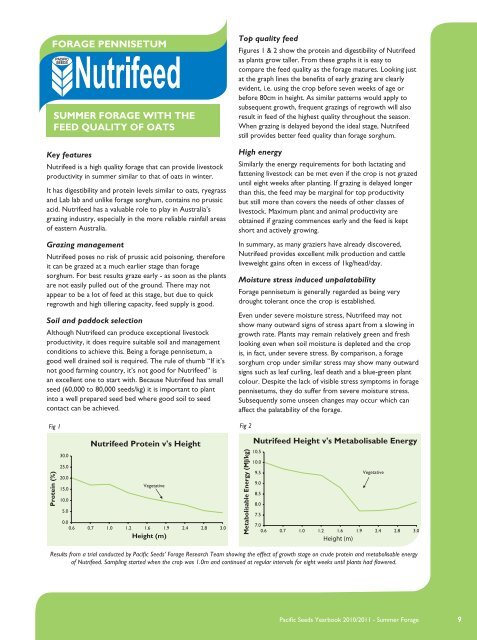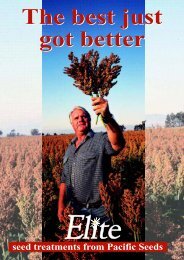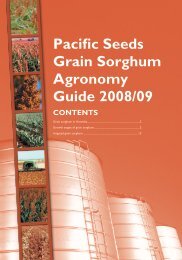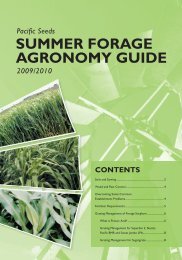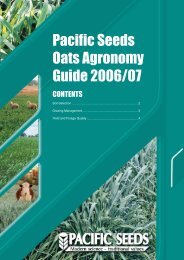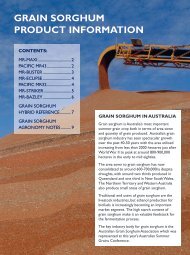SUMMER FORAGE pROdUct inFORMAtiOn - Directrouter.com
SUMMER FORAGE pROdUct inFORMAtiOn - Directrouter.com
SUMMER FORAGE pROdUct inFORMAtiOn - Directrouter.com
- No tags were found...
You also want an ePaper? Increase the reach of your titles
YUMPU automatically turns print PDFs into web optimized ePapers that Google loves.
<strong>FORAGE</strong> PENNISETUM<br />
Summer forage with the<br />
feed quality of oats<br />
Key features<br />
Nutrifeed is a high quality forage that can provide livestock<br />
productivity in summer similar to that of oats in winter.<br />
It has digestibility and protein levels similar to oats, ryegrass<br />
and Lab lab and unlike forage sorghum, contains no prussic<br />
acid. Nutrifeed has a valuable role to play in Australia’s<br />
grazing industry, especially in the more reliable rainfall areas<br />
of eastern Australia.<br />
Grazing management<br />
Nutrifeed poses no risk of prussic acid poisoning, therefore<br />
it can be grazed at a much earlier stage than forage<br />
sorghum. For best results graze early - as soon as the plants<br />
are not easily pulled out of the ground. There may not<br />
appear to be a lot of feed at this stage, but due to quick<br />
regrowth and high tillering capacity, feed supply is good.<br />
Soil and paddock selection<br />
Although Nutrifeed can produce exceptional livestock<br />
productivity, it does require suitable soil and management<br />
conditions to achieve this. Being a forage pennisetum, a<br />
good well drained soil is required. The rule of thumb “If it’s<br />
not good farming country, it’s not good for Nutrifeed” is<br />
an excellent one to start with. Because Nutrifeed has small<br />
seed (60,000 to 80,000 seeds/kg) it is important to plant<br />
into a well prepared seed bed where good soil to seed<br />
contact can be achieved.<br />
Top quality feed<br />
Figures 1 & 2 show the protein and digestibility of Nutrifeed<br />
as plants grow taller. From these graphs it is easy to<br />
<strong>com</strong>pare the feed quality as the forage matures. Looking just<br />
at the graph lines the benefits of early grazing are clearly<br />
evident, i.e. using the crop before seven weeks of age or<br />
before 80cm in height. As similar patterns would apply to<br />
subsequent growth, frequent grazings of regrowth will also<br />
result in feed of the highest quality throughout the season.<br />
When grazing is delayed beyond the ideal stage, Nutrifeed<br />
still provides better feed quality than forage sorghum.<br />
High energy<br />
Similarly the energy requirements for both lactating and<br />
fattening livestock can be met even if the crop is not grazed<br />
until eight weeks after planting. If grazing is delayed longer<br />
than this, the feed may be marginal for top productivity<br />
but still more than covers the needs of other classes of<br />
livestock. Maximum plant and animal productivity are<br />
obtained if grazing <strong>com</strong>mences early and the feed is kept<br />
short and actively growing.<br />
In summary, as many graziers have already discovered,<br />
Nutrifeed provides excellent milk production and cattle<br />
liveweight gains often in excess of 1kg/head/day.<br />
Moisture stress induced unpalatability<br />
Forage pennisetum is generally regarded as being very<br />
drought tolerant once the crop is established.<br />
Even under severe moisture stress, Nutrifeed may not<br />
show many outward signs of stress apart from a slowing in<br />
growth rate. Plants may remain relatively green and fresh<br />
looking even when soil moisture is depleted and the crop<br />
is, in fact, under severe stress. By <strong>com</strong>parison, a forage<br />
sorghum crop under similar stress may show many outward<br />
signs such as leaf curling, leaf death and a blue-green plant<br />
colour. Despite the lack of visible stress symptoms in forage<br />
pennisetums, they do suffer from severe moisture stress.<br />
Subsequently some unseen changes may occur which can<br />
affect the palatability of the forage.<br />
Fig 1 Fig 2<br />
Results from a trial conducted by Pacific Seeds’ Forage Research Team showing the effect of growth stage on crude protein and metabolisable energy<br />
of Nutrifeed. Sampling started when the crop was 1.0m and continued at regular intervals for eight weeks until plants had flowered.<br />
Pacific Seeds Yearbook 2010/2011 - Summer Forage 9


